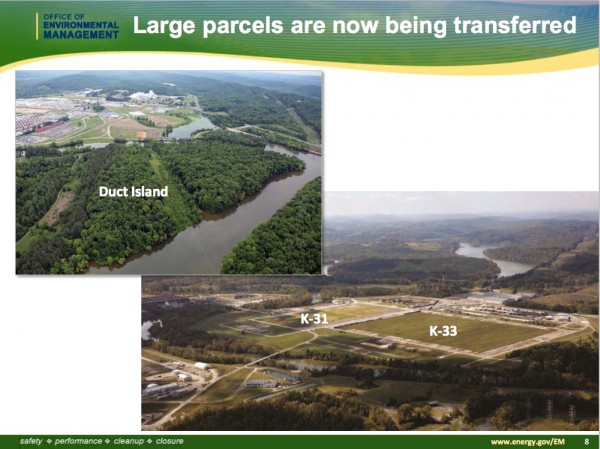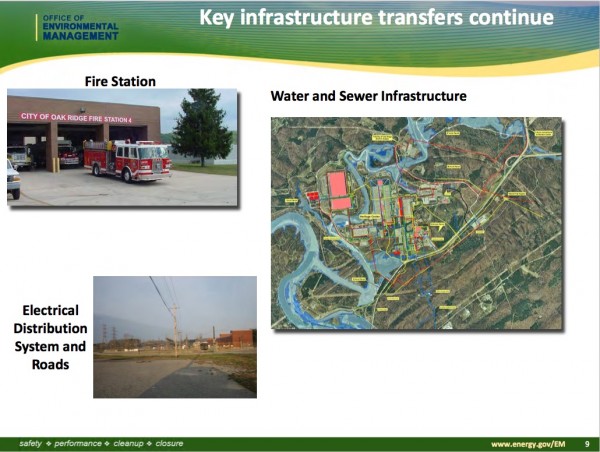
The image above showing reindustrialization progress at East Tennessee Technology Park comes from a presentation on Oct. 11, 2017, by Dave Adler by the U.S. Department of Energy’s Oak Ridge Office of Environmental Management. The K-31/K-33 area is the blue area at the top right side of the ETTP site, and Duct Island is the purple/pink area just below it and slightly to the left. The former K-25 Building was in the yellow area at center. The proposed airport is at the bottom right in the blue and purple/pink area on the north side of State Route 58.
About 185 acres in the northwest corner of Heritage Center, the former K-25 site, have been transferred to the Community Reuse Organization of East Tennessee.
CROET is a nonprofit organization that helps find new uses for former U.S. Department of Energy property.
The 185 acres transferred to CROET at Heritage Center are where the K-31 and K-33 buildings used to be. The property transfer was recorded at the Roane County courthouse on October 10, said Lawrence Young, CROET president.
“We hope to be able to attract, over time, larger industrial clients,” Young said Monday.
The parcels are currently vacant, and they have been cleaned up by the U.S. Department of Energy and UCOR, DOE’s cleanup contractor in Oak Ridge. There should not be any impediments to using the parcels as industrial property from an environmental standpoint, Young said.
“Like all brownfield sites, there are issues with foundations and other abandoned utility structures that will need to be addressed when constructing new industrial facilities,” Young said. “It is permitted to be used for all uses currently allowed in the city’s Industrial 2 zone.”
CROET has submitted a request to transfer the area known as Duct Island at the former K-25 site, which is also known as East Tennessee Technology Park or Heritage Center. Duct Island is a peninsular land mass of about 180-200 acres on the west side of ETTP.
That transfer should be under congressional review now, Young said.
“We are hopeful of receiving the property within the last quarter of 2017,” he said.
Oak Ridge Today asked how the property transfer process works. Here is Young’s response:
“We submit a request to DOE’s Oak Ridge Environmental Management office. DOE undertakes to analyze the property for suitability to transfer. Typically, a large package of materials is developed supporting the transfer request. EPA reviews and signs off on the package, the governor’s office does the same, and the package is then forwarded to DOE Headquarters for their review and concurrence. Upon receipt of a signature by the secretary of energy, the request is forwarded to Congress, upon which it sits in review for a 60-day period.
“Should it proceed through all of those gateways, often taking years to do so, it is then returned to the Oak Ridge Office, where a deed is prepared and the property is conveyed to CROET. CROET usually does not pay for the property as one of the DOE review criteria is ‘benefit to the government.’ Often though, we have significant costs associated with legal preparation and review, resubdivision and surveying costs, and assumption of the liabilities associated with removal of structures (including the aforementioned abandoned utility structures) after their useful life.”

Large parcels being transferred or already transferred at East Tennessee Technology Park, also known as Heritage Center or the former K-25 site, are the K-31/K-33 area and Duct Island. The image above comes from a presentation on Oct. 11, 2017, by Dave Adler by the U.S. Department of Energy’s Oak Ridge Office of Environmental Management to the Oak Ridge Site Specific Advisory Board.
Demolition work at K-31 was completed in June 2015. It was the fourth of the five large uranium-enriching buildings to be demolished at ETTP. K-33 was demolished before K-31. The demolition of those two buildings, which used a process called gaseous diffusion to enrich uranium, meant that about 200 acres of flat land was available for industrial development, officials said during a demolition ceremony on June 26, 2015.
“It’s the largest parcel of land available at ETTP,” said Sue Cange, former manager of the U.S. Department of Energy’s Oak Ridge Office of Environmental Management.
Infrastructure is already in place, including water, sewer, roads, and electricity, Cange said. Also, ETTP is close to Interstate 40, a short rail line, and possibly an airport. (There are plans to build an airport on the south side of Heritage Center, along State Route 58.)
ETTP, which has also been known as Oak Ridge Gaseous Diffusion Plant, was built as part of the Manhattan Project in World War II. That was a top-secret federal program to build the world’s first atomic bombs. Officials say the site helped to win World War II and the Cold War, enriching uranium for atomic weapons and commercial nuclear power plants.
Operations ended in 1985, and the site was permanently shut down in 1987. DOE then began cleanup operations and—with the help of contractors, CROET, and others–is converting it into a large private industrial park. The cleanup work includes demolition of many of the buildings at the site, including the former mile-long, U-shaped K-25 Building, which was once the world’s largest building under one roof.
DOE finished demolition on K-27, the last of the big five uranium-enriching buildings at ETTP, in August 2016. Federal officials plan to complete the environmental cleanup project and transfers by 2020.
Young said CROET has about 350 acres transferred from DOE at Heritage Center. CROET had about 500 acres transferred from DOE at Horizon Center, a short drive toward Oak Ridge from Heritage Center, in the early 2000s. But that Horizon Center land has been transferred to the Oak Ridge Industrial Development Board, which now manages it.
A total of about 1,000 acres has been transferred over the past 20 years, Young said.
More information will be added as it becomes available.

The image above outlines some of the infrastructure transfers at East Tennessee Technology Park, also known as Heritage Center or the former K-25 site. This image is from a presentation on Oct. 11, 2017, by Dave Adler by the U.S. Department of Energy’s Oak Ridge Office of Environmental Management to the Site Specific Advisory Board.

The vision for what East Tennessee Technology Park could eventually look like. Demolition work on the five large gaseous diffusion buildings—K-25, K-27, K-29, K-31, and K-33—was completed in August 2016. The environmental cleanup at ETTP, once used to enrich uranium for atomic weapons and commercial nuclear power plants, is expected to be finished in 2020. The image above comes from a presentation on Oct. 11, 2017, by Dave Adler by the U.S. Department of Energy’s Oak Ridge Office of Environmental Management to the Site Specific Advisory Board.

Officials say East Tennessee Technology Park, the former uranium-enriching K-25 site, helped win World War II and the Cold War, and there are plans to commemorate the work that occurred there from the Manhattan Project during World War II until the site was shut down in the mid-1980s. The image above comes from a presentation on Oct. 11, 2017, by Dave Adler by the U.S. Department of Energy’s Oak Ridge Office of Environmental Management to the Site Specific Advisory Board.
Do you appreciate this story or our work in general? If so, please consider a monthly subscription to Oak Ridge Today. See our Subscribe page here. Thank you for reading Oak Ridge Today.
Copyright 2017 Oak Ridge Today. All rights reserved. This material may not be published, broadcast, rewritten, or redistributed.
Leave a Reply